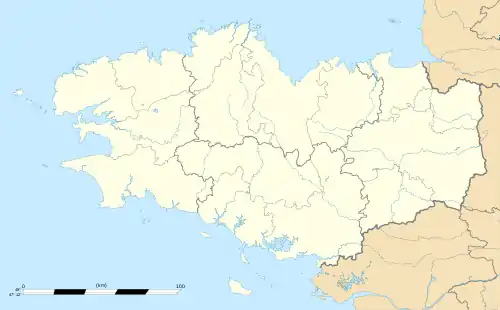Grand-Champ
Grand-Champ (Breton: Gregam) is a commune in the Morbihan department of Brittany in north-western France.
Grand-Champ
Gregam | |
|---|---|
 The church of Saint-Tugdual | |
.svg.png.webp) Coat of arms | |
Location of Grand-Champ 
| |
 Grand-Champ  Grand-Champ | |
| Coordinates: 47°45′33″N 2°50′36″W | |
| Country | France |
| Region | Brittany |
| Department | Morbihan |
| Arrondissement | Vannes |
| Canton | Grand-Champ |
| Intercommunality | Golfe du Morbihan - Vannes agglomération |
| Government | |
| • Mayor (2020–2026) | Yves Bleunven[1] |
| Area 1 | 67.34 km2 (26.00 sq mi) |
| Population (2017-01-01)[2] | 5,404 |
| • Density | 80/km2 (210/sq mi) |
| Time zone | UTC+01:00 (CET) |
| • Summer (DST) | UTC+02:00 (CEST) |
| INSEE/Postal code | 56067 /56390 |
| Elevation | 28–167 m (92–548 ft) (avg. 127 m or 417 ft) |
| 1 French Land Register data, which excludes lakes, ponds, glaciers > 1 km2 (0.386 sq mi or 247 acres) and river estuaries. | |
Demographics
Inhabitants of Grand-Champ are called in French Grégamistes. Grand-Champ counted 5,404 inhabitants in 2017, an increase of 14% compared to 2007.
Geographics
This midtown is 15th kilometers north-west away from Vannes.
Breton language
In 2008, there were 7,77% of the children attending the bilingual schools in primary education.[3]
History
There are many references to Roi Stevan, that's why the motto of this town is : Grand-Champ, King Stevan Home.
- Bataille de Grand-Champ in 1795, during chouannerie repression.
- On 1 December 1870, the Balloon mail Bataille-de-Paris, created by Jules Antoine Lissajous starts from Gare du Nord in Paris, at this time besieged by Prussians, and ends 460 kilometers away in Grand-Champ.[4]
Places and monuments
- Saint Tugdual church (1866-1977). This church has, in its nave, two wooden-made panels coming from Notre-dame of Burgo Chapel.
- Chapel Notre-Dame-du-Perpétuel-Secours (1898).
- Chapelle Sainte-Brigitte à Loperhet (1560-1588).
- Chapel of Lopabu (around 1520).
- Chapelle Notre-Dame au Burgo (1520-1540) - historical monument (France).
- Chapel Notre-Dame-des-Fleurs au Moustoir des Fleurs (beginning of 15th century).
- Fountain de Loperhet (end of 16th century).
- Fountain de Burgo (1573) - historical monument.
- Calvary of Lopabu (1520).
- Moustoir des Fleurs calvary (16th century).
- Croix au centre du cimetière.
- Castle of Penhoët (1756) known simply as « Grand-Champ », owned by the Prince Obolensky, Arnaud Henry Salas-Perez.
- Castle of Rest (15th century).
- Manor de Kermainguy (15th century).
- Manor de Kerleguen (1427).
- Well of Locmeren-des-Prés.
See also
References
- Sources
- Citations
- "Maires du Morbihan" (PDF). Préfecture du Morbihan. 7 July 2020.
- "Populations légales 2017". INSEE. Retrieved 6 January 2020.
- (in French) Ofis ar Brezhoneg: Enseignement bilingue
- Ballon No. 38 : « La Bataille-de-Paris »
External links
| Wikimedia Commons has media related to Grand-Champ. |
- Official site (in French)
- Base Mérimée: Search for heritage in the commune, Ministère français de la Culture. (in French)
- Mayors of Morbihan Association (in French)
This article is issued from Wikipedia. The text is licensed under Creative Commons - Attribution - Sharealike. Additional terms may apply for the media files.